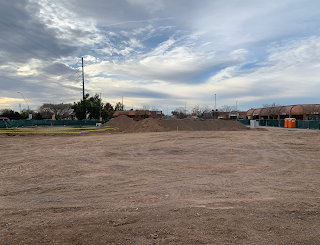Crossing into California from Arizona through Parker before the automobile bridge
Even though my main interest is in Phoenix history, you really can't understand Phoenix without including California. If you go back to the 1800s, it was the connection to San Francisco, and after the beginning of the 20th Century, it was the connection to Los Angeles.
And the story goes from ships sailing up into the Gulf of California to haul things into Arizona via Yuma, and then to trains, but what really captures my attention is when automobiles started to become popular, and people wanted to drive between Los Angeles and Phoenix, in the earliest part of the 20 Century.
The earliest daredevils who did the trip would actually cross at Yuma, where hopefully they wouldn't get stuck in the muck and mud. Certainly there wasn't any other way to cross the Colorado River north of there - cars can't swim, and it was illegal, and probably not smart, to drive a car over a railroad bridge. So it all started with the old-fashioned idea of a ferry - a small boat that carried automobiles from one side of the river to the other. I visited the site of a ferry that was in operation for a very long time in Parker, Arizona.
 |
| 1916 map showing the location of Bush's Ferry, at left, in Parker, and the automotive route to Phoenix, paralleling the train tracks. I turned the map sideways because I like north to be facing up. |
For me, it started with an article, and a map that I found in a newspaper from the Library of Congress from 1918. It showed the route between Phoenix and California, via what was called the Parker Cut-Off. It's been explained to me that a cut-off is a short cut, but it's certainly isn't the shortest distance between Phoenix and Los Angeles, that would be the crossing that I've gone over many times, at Blythe. So I've never even thought about crossing at Parker, but people did for a long time.
The ferry was run by a "mom and pop" couple named Joe and Nellie Bush. You can Google them to get more information. As usual, I found way too much information when I started my research, and just wanted to know exactly where the ferry was. That's what I call "putting my feet on the ground". Luckily I talked to someone who had known the family, and he directed me to the exact spot. An historical marker would have been nice, but at least I could stand right there, which is the pic at the top of this post.
 |
| 1918 ad for Bush's Ferry, and the Parker Cut-Off Hotel and Garage, Parker, Arizona. |
I imagined what the route into Phoenix would have been like in 1918. Pretty rough, and no paving! Of course cars back then didn't have air conditioning, or a place to plug in your cell phone, so it must have been pretty primitive. I'd imagine only very tough and adventurous people would have been doing it back then, although there must have been plenty, as the ferry kept busy, and could do three cars at a time. From what I've read, in later years it could carry six at at time. Of course when the automobile bridge was built, in 1937, the ferry wasn't needed any more.
Standing on the Arizona side of the river, looking towards California, you could see that the water wasn't very deep. But it would have been too deep for cars! And I'm sure the people in the trains, relaxing in comfort, would have looked at the people in the cars, being ferried across to battle miles of dusty and rough roads, as a little crazy. But ultimately the cars took over, and traveling on trains became something that nowadays people like me don't even think about.
Image at the top of this post: the location of Bush's Ferry, just north of the railroad bridge, which is just north of the automobile bridge, Parker, Arizona. You're looking west towards California.
If you liked this article, and would like to see more, please consider subscribing to history adventuring on Patreon. If you're already a subscriber, thank you! You make this happen!
Click here to become a Patron!
History adventuring posts are shared there daily. The basic tier is a dollar a month, and the PhD tier, which includes "then and now" photos, billboards, aerials, videos, and super high-definition photos, is five dollars a month, and is discounted for seniors, veterans, and students.




Comments
Post a Comment